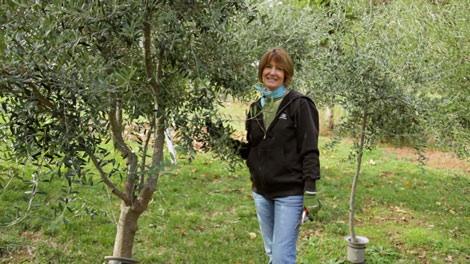How should we think about olive growing zones?
USDA Zone 7 is typically considered too cold for olive trees.
But we're gardeners, which means we want to grow beautiful trees that aren't recommended for our zones. That goes both ways too -- for every New Yorker wanting a Meyer lemon tree we have a Southern Californian longing to grow Bartlett pears.
 Tricia plants an olive tree in our latest video and that probably has you fired up about the beautiful and long-lived trees, with their crop of health-giving fruit. Here's how to push the envelope for olives in your climate.
Tricia plants an olive tree in our latest video and that probably has you fired up about the beautiful and long-lived trees, with their crop of health-giving fruit. Here's how to push the envelope for olives in your climate. 
Classic ways to find warmth for olives in your zone
Find the warm microclimates on your property Microclimates are the hotter and cooler parts of your landscape. Tips for locating warm microclimates: Up against the wall Heat will reflect from a south or west-facing wall of your house, outbuilding or wooden fence. The stored heat from the daytime will continue to warm the tree at night, raising the temperatures by several degrees. Plant an olive near one of those structures (allowing room for mature olive tree branches and good air circulation around the tree). Facing south or west Garden areas that get full southern exposure are the warmest parts of the landscape. Western exposures come next as hot spots. An eastern exposure captures morning sun, but is shaded in the afternoon, so there is not enough additional heat to really create a warmer microclimate. Higher is better The upper part of a slope will be warmer than the lower part. Cold air heads down hills and into valleys, bringing cooler temperatures and increased potential for frost. 
Olive varieties that are more cold-tolerant
Typical olives trees will be damaged by temperatures below 17F and may not survive temperatures below 10F. A few varieties are a bit tougher and more likely to make it through cold spells. If you're in USDA Zone 7, we recommend Mission and Arbequina olive trees.


28 comments
We live a dozen or so miles north of Boston. Many years ago a small guest house sat on top of the abandoned foundation in our yard. Our plan is to build a greenhouse (10-ft x 22-ft inside dimensions) and grow a few olive trees in about a 6-ft x 4-ft plot against the back wall. Do you think this is a feasible idea?
Melanie, those trees can get to 15 feet tall and probably 8-10 feet in diameter. If you are going to move them, the winter is the least stressful time to dig them up, as long as they are not too big. You can remove the suckers anytime.
Melanie, those trees can get to 15 feet tall and probably 8-10 feet in diameter. If you are going to move them, the winter is the least stressful time to dig them up, as long as they are not too big. You can remove the suckers anytime.
Hi Suzanne,
Thank you for the wonderful videos and information. I’m learning so much! I’m in Central TX in zone 8b and bought a few Arbequinas from a local nursery. How large can I expect them to grow in optimal conditions? I planted them near the house but not super close and now I’m concerned that they might be too close if the tree gets too large. If so, would the fall be a better time to transplant the tree elsewhere in the yard? Also, from the videos I think it says to prune just the smaller suckers the first 4 years and not often. Should I do that in the summer?
Thank you!
Katy, it is really difficult to give you advise on how to control a mystery pest. Try going out at night with a flash light and see if you can spot what is eating your tree. The other thing you can try is to put out a sticky trap (yellow or blue) and see if you catch anything that way, but this only catches flying insects, not any caterpillars. Look on the underside of your leaves as well as on top.